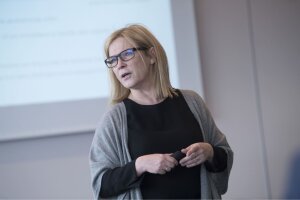
I've been talking about digital maturity and different generations of it for many years, and for almost as many years I've been asked by leaders how to close the gap between current digital maturity and future desirability.
For many years, I've also depicted my model of digital maturity as a staircase - a generational staircase, as others, and now myself, refer to it. Each generation has its own step, with each generation building on the previous step, and each step requires the development of organizational capabilities, foundations to be built and leadership skills to be learned at each step to ensure a solid and secure staircase.
"Can't you skip a step?" I've been asked this question for many years. My answer has been that you can, but you need to be aware of the complexity you create - the fragility you add to the staircase. A fragility that arises when you fail to develop the organizational capabilities and build the competencies and foundations necessary for a stable staircase.
"Do you have to be on the same step throughout the organization, you can't really do that, can you?" is a question I've often heard from people who have either read one of my books, attended a course or participated in a workshop. My answer has been that it's absolutely true. Different areas of the organization are in different places and need to be managed differently. An awareness of how mature different areas are is necessary and strategic prioritization of how mature the areas should be should be made.
"The staircase and generations resonate really well for me, but how can we work on increasing digital maturity? And whose responsibility is that?" I've also heard for many years when I've presented the generational staircase. The answer to this question has been that increasing digital maturity requires efforts in many areas. Capabilities to be developed, foundations to be built, mindsets and competencies to be developed. The responsibility for this and thus the digital maturity of the organization is a shared leadership issue and will require something from all leaders.
All these questions call for an attention to the gap - should it be closed as "Closing the Gap", should it be managed as "Manage-the-Gap", or is it really more about "Mind the Gap"? Let me share my ongoing reflections on these first.
I tend to lean towards the latter and have therefore delved a little deeper into this concept. You may know it from London. "Mind the Gap" originates from London Underground. "Mind the Gap" is a warning that is repeated as a recorded message over the loudspeakers at tube stations as you enter and exit the tube. The warning refers to the gap that may exist between the platform and the train when the doors open.
I asked my chatbot how this can be applied to organizational contexts in general and it gave, in my opinion, a great answer: "Ultimately, 'Mind the Gap' is about being aware of differences and actively working to overcome them to achieve better understanding, efficiency and collaboration in a given context". I will continue to work on Mind the Gap in relation to digital maturity in the coming months as I work on a new book manuscript.
So what does it take for leaders to "mind the gap" in a digital maturity context? Let me give my initial reflections on what I will tentatively call "Mind-the-Gap leadership":
Increased digital maturity and mind-the-gap will not happen by itself, and I would argue that there is a need to appoint a leader, preferably at the top management level, whose task it is to ensure that the digital maturity of the organization as a whole is increased and that the various gaps that exist in the organization are visible to everyone so that the right managerial and strategic priorities can be set. Is this a task for the Chief Digital Officer, or should another profile be "appointed" to this role? This is a question I've been asking myself over the past few months, and I will continue to reflect on it until my next column, which I think should be about just that.
If this column has given you food for thought, or if you have any questions or comments about what you've just read, I'd love to hear from you. Otherwise, I hope you have enjoyed reading the column and that you want to read the next one in December.